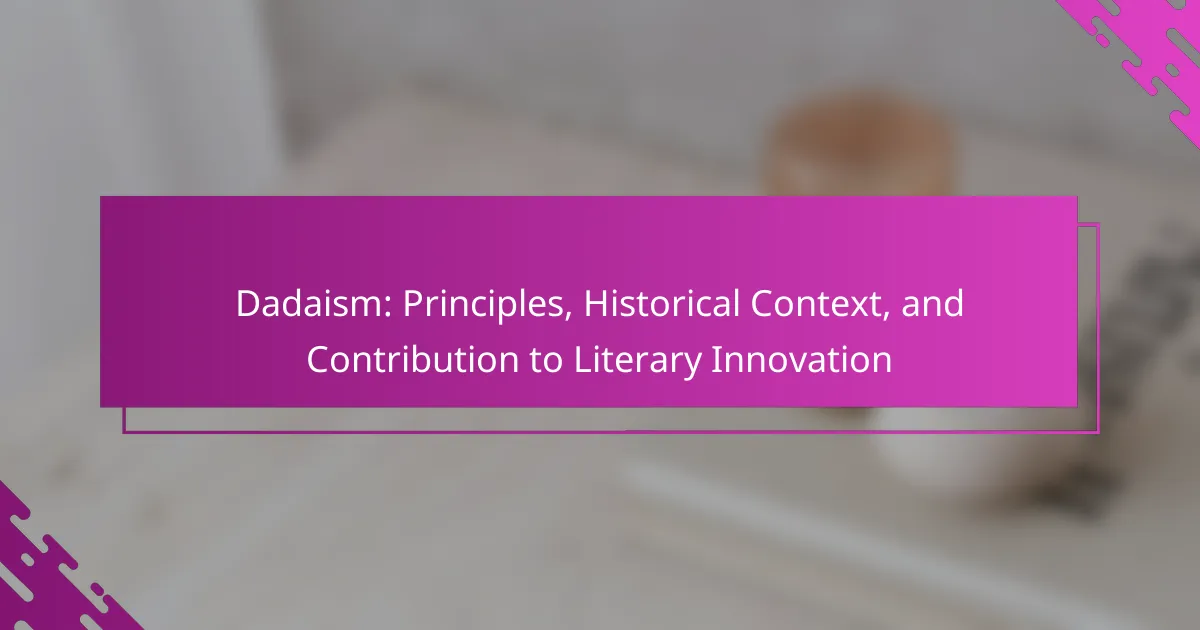Stream of consciousness enhances reader engagement by immersing them in characters’ thoughts. This article explores its narrative structure, notable examples like Joyce and Woolf, and its effects on emotional connection. It also addresses the challenges writers face when using this technique and provides tips for effective analysis. Understanding this style can deepen appreciation for modern literature.
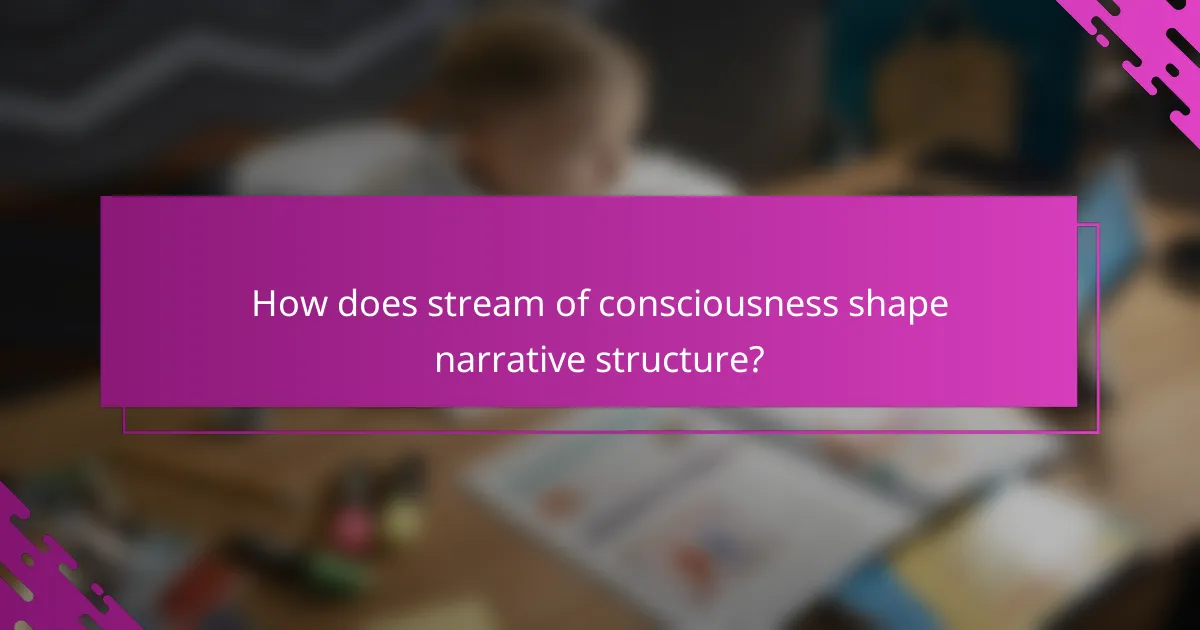
How does stream of consciousness shape narrative structure?
Stream of consciousness profoundly shapes narrative structure by immersing readers in characters’ thoughts. This technique creates a fluid, nonlinear experience, reflecting the complexity of human consciousness. It often blurs the lines between reality and perception, enhancing emotional engagement. Notable examples include James Joyce’s “Ulysses” and Virginia Woolf’s “Mrs. Dalloway,” where internal monologues reveal deeper truths about characters. This narrative style fosters a unique reader experience, promoting empathy and understanding of psychological states.
What are the key characteristics of stream of consciousness writing?
Stream of consciousness writing is characterized by its flow of thoughts, often lacking conventional structure. This style emphasizes inner monologue and personal perspective, creating a deep connection with the reader. Key characteristics include non-linear narrative, fragmented sentences, and a focus on sensory experiences. These elements contribute to an immersive reading experience, allowing readers to engage with the character’s mind directly.
Which authors are known for their use of stream of consciousness?
Notable authors known for their use of stream of consciousness include James Joyce, Virginia Woolf, and William Faulkner. These writers employ this narrative technique to explore the inner thoughts and feelings of characters, often blurring the line between reality and perception. Joyce’s “Ulysses” exemplifies this style, while Woolf’s “Mrs. Dalloway” and Faulkner’s “The Sound and the Fury” further showcase its effects on reader experience. Each author uniquely captures the fluidity of thought, enhancing emotional depth and complexity in their narratives.
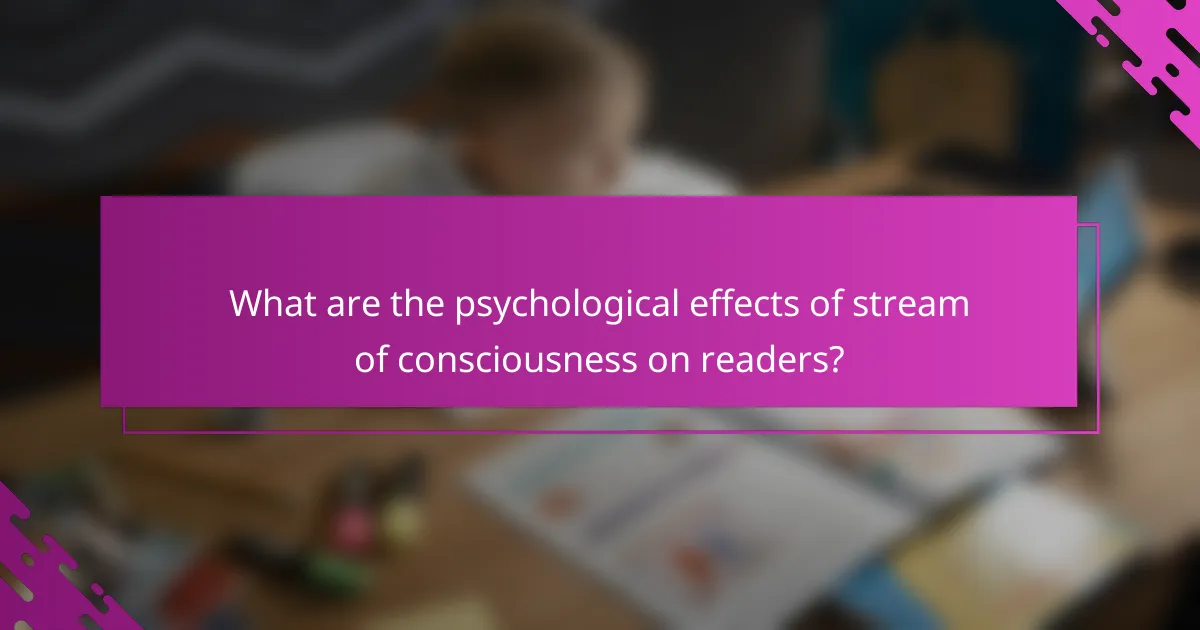
What are the psychological effects of stream of consciousness on readers?
Stream of consciousness can profoundly impact readers’ psychological experiences, fostering deep emotional connections and self-reflection. This narrative style immerses readers in characters’ thoughts, enhancing empathy and understanding. As a result, readers may experience heightened awareness of their own feelings and thoughts. The unique attribute of stream of consciousness is its ability to mimic real-time thought processes, creating an intimate reading experience. This can lead to a rare effect where readers feel as though they are part of the character’s inner world, promoting introspection and personal insight.
How does stream of consciousness influence reader engagement?
Stream of consciousness significantly enhances reader engagement by immersing them in characters’ thoughts. This narrative style creates a deeper emotional connection and encourages readers to experience the story intimately. It often reflects the complexities of human psychology, making the reading experience more relatable and engaging. The unique attribute of this technique lies in its ability to convey fragmented thoughts, mirroring real-life mental processes. As a result, readers may find themselves more invested in the characters and their journeys.
What emotional responses does stream of consciousness evoke?
Stream of consciousness evokes a range of emotional responses, including empathy, confusion, and introspection. This narrative style immerses readers in characters’ thoughts, fostering a deep connection to their emotional states. As a result, readers often experience heightened feelings of vulnerability and authenticity, reflecting the complex inner lives of the characters. This technique can lead to both catharsis and discomfort, as it challenges conventional storytelling methods.
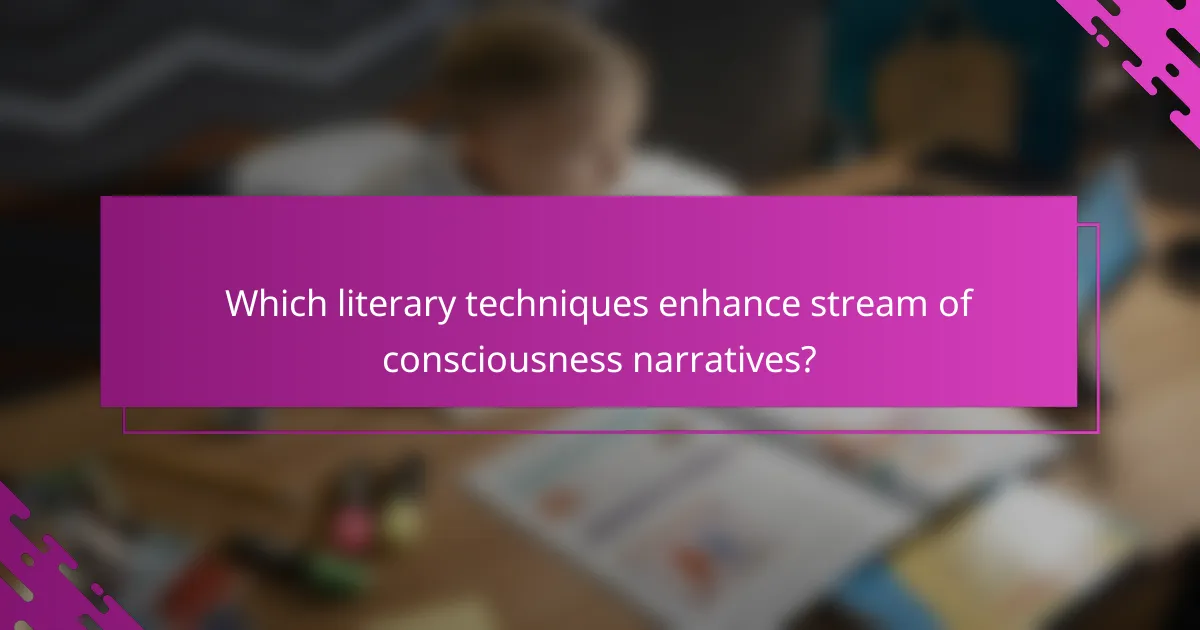
Which literary techniques enhance stream of consciousness narratives?
Literary techniques that enhance stream of consciousness narratives include free association, interior monologue, and fragmented syntax. These techniques create an immersive experience, allowing readers to engage with characters’ thoughts and feelings in real-time. Free association enables a flow of ideas that mirrors natural thought patterns, while interior monologue provides direct access to a character’s psyche. Fragmented syntax reflects the chaotic nature of consciousness, adding depth and authenticity to the narrative.
How do free indirect discourse and interior monologue function in this style?
Free indirect discourse and interior monologue create a fluid narrative style that mirrors characters’ thoughts. They allow readers to experience the inner workings of characters’ minds, enhancing emotional depth. Free indirect discourse blends the narrator’s voice with a character’s perspective, while interior monologue presents thoughts directly, often in a fragmented manner. This technique immerses readers in the characters’ consciousness, fostering a deeper connection and understanding of their experiences.
What role does punctuation play in stream of consciousness?
Punctuation in stream of consciousness serves to reflect the chaotic nature of thought. It creates rhythm, emphasizes emotional states, and guides reader interpretation of the narrative flow. Unique uses of punctuation can differentiate characters’ voices and enhance the immersive experience. For example, dashes may indicate interruptions, while ellipses suggest hesitation.
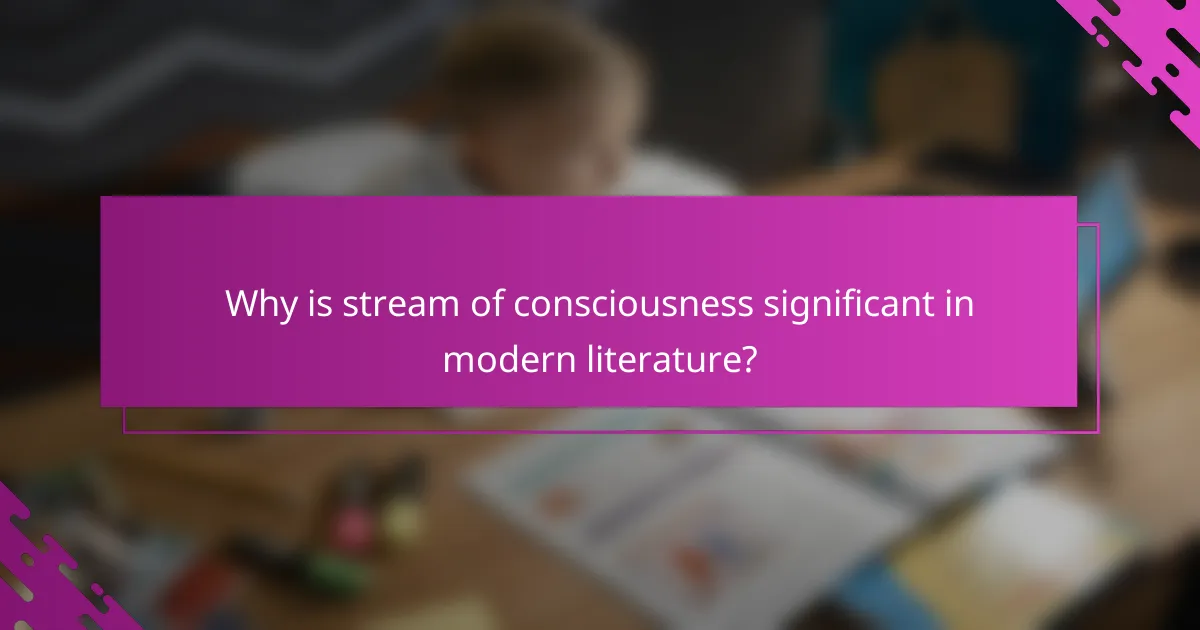
Why is stream of consciousness significant in modern literature?
Stream of consciousness is significant in modern literature because it captures the inner thoughts and emotions of characters in a fluid, unstructured manner. This technique allows readers to experience the character’s psyche directly, fostering deep emotional connections. Notable examples include James Joyce’s “Ulysses” and Virginia Woolf’s “Mrs. Dalloway,” which showcase the complexity of human consciousness. The effect on reader experience is profound, as it encourages active engagement and interpretation, making readers feel as if they are navigating the character’s mind. This immersive quality enhances the overall narrative depth and realism in literature.
How does it reflect contemporary themes and issues?
Stream of consciousness reflects contemporary themes and issues by capturing the fragmented nature of modern life. This narrative technique mirrors the complexity of human thought, emphasizing individual perception and emotional experience. It often addresses themes such as identity, mental health, and societal disconnection, showcasing the struggle for coherence in a chaotic world. Authors like Virginia Woolf and James Joyce use this style to explore characters’ inner lives, revealing deeper truths about the human condition. As a result, readers gain insight into contemporary challenges, fostering empathy and understanding.
What cultural contexts influence its interpretation?
Cultural contexts significantly shape the interpretation of stream of consciousness. Literary movements, such as modernism, emphasize subjective experience, influencing how readers engage with this narrative style. Historical events, social norms, and psychological theories also inform understanding. For instance, the rise of existentialism in the early 20th century affected how characters’ inner thoughts are perceived. Additionally, cultural backgrounds of readers can lead to varied interpretations of themes and emotions presented in stream of consciousness narratives.
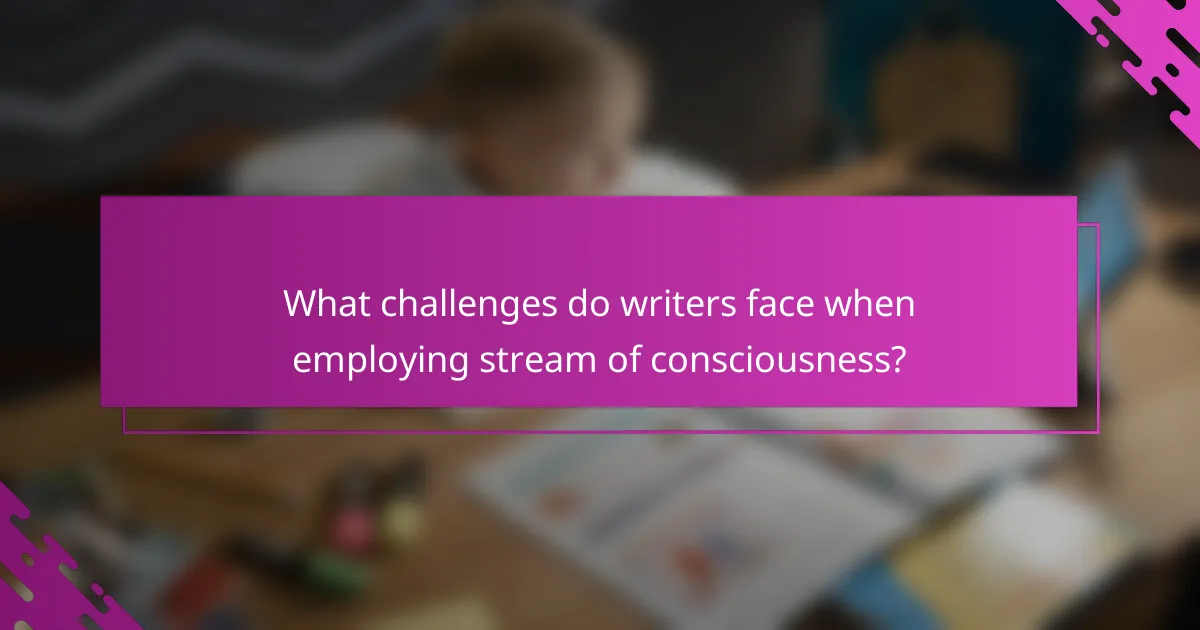
What challenges do writers face when employing stream of consciousness?
Writers face several challenges when employing stream of consciousness techniques. These include maintaining coherence, managing pacing, and ensuring reader engagement. The nonlinear narrative can confuse readers, making it difficult to follow the storyline. Additionally, writers must balance character thoughts with external actions to create a seamless flow. This style requires a deep understanding of the characters’ psyche, which can be demanding and time-consuming. Ultimately, the risk of alienating readers is high if the execution lacks clarity and purpose.
How can the complexity of thought processes be effectively conveyed?
Stream of consciousness effectively conveys complex thought processes by immersing readers in the character’s inner experiences. This narrative technique captures the fluidity of thoughts, emotions, and sensory perceptions, creating a direct connection to the reader’s own cognitive experiences. The lack of structured dialogue or clear transitions reflects the chaotic nature of human thought, enhancing realism and engagement. For example, works by Virginia Woolf and James Joyce exemplify this style, allowing readers to experience a character’s mental state in real time. The effect on reader experience is profound, as it fosters empathy and a deeper understanding of the characters’ motivations and struggles.
What common pitfalls should writers avoid?
Writers should avoid excessive complexity, lack of focus, and overuse of punctuation in stream of consciousness writing. These pitfalls can confuse readers and obscure the intended message. Maintaining clarity and coherence is essential for enhancing reader experience. Additionally, failing to establish a clear narrative thread can lead to disengagement.

What are best practices for reading and analyzing stream of consciousness texts?
To effectively read and analyze stream of consciousness texts, focus on the flow of thoughts and emotions. Identify shifts in perspective and note the use of non-linear narrative structures. Pay attention to sensory details and internal monologues, which reveal character motivations and feelings. Engage with the text by reflecting on your own thoughts and emotions as you read, enhancing your personal connection to the material. Consider the historical and cultural context of the work, as this can influence the narrative style and themes.
How can readers enhance their understanding of this narrative style?
Readers can enhance their understanding of stream of consciousness by actively engaging with the text. They should focus on the flow of thoughts and emotions presented, noting how the narrative reflects the inner workings of characters. Analyzing the use of punctuation, syntax, and fragmented sentences can reveal deeper meanings. Comparing different authors’ styles helps highlight unique attributes of this narrative technique, enriching the overall reading experience. Finally, discussing interpretations with others can provide fresh perspectives and insights.
What strategies can be used to appreciate the nuances of stream of consciousness?
To appreciate the nuances of stream of consciousness, readers should focus on character thoughts, non-linear narratives, and sensory details. Engaging with the internal monologue enhances understanding of character motivations. Analyzing shifts in time and perspective reveals deeper emotional layers. Familiarity with authors like Virginia Woolf or James Joyce illustrates the technique’s complexity. Reading aloud can also help capture rhythm and flow, enriching the overall experience.



